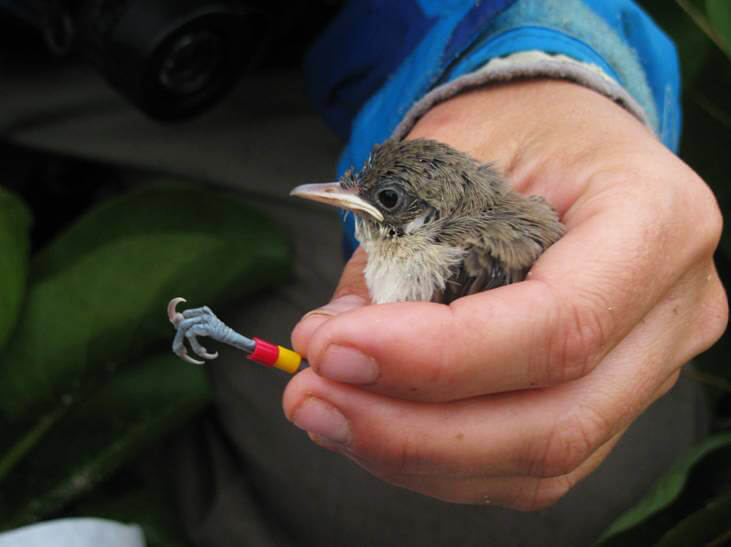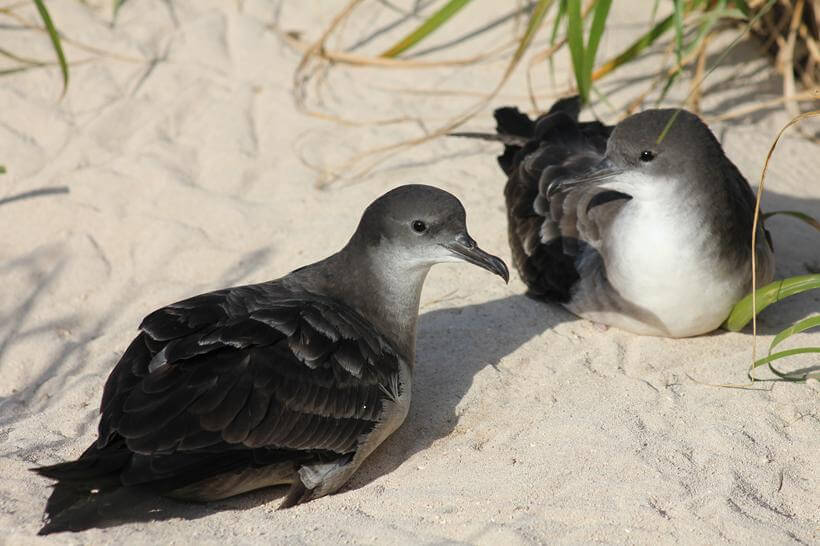Flurry of Activity on Laysan
April 8 – April 21, 2013
Megan Dalton

One of five Nihoa Millerbird nestlings banded so far this 2013 season on Laysan. This chick was banded Y/R:BK/Y (yellow over red on the left leg, black over yellow on the right leg) at approximately 13 days old.
Photo credit: Megan Dalton
My first month on Laysan, where I'm helping to monitor the recently reintroduced Millerbird population, has been a bit of a whirlwind. So many new sights and sounds to take in and places to explore on this island, while simultaneously trying to get settled into camp and, most excitingly, jumping right into our Millerbird monitoring tasks.
It's been a challenge to catch up on all the Millerbirds' movements, pairings, and activities since the field crew was evacuated last fall, especially since there appear to be many more younger, unbanded birds in the area trying to stake out their own territories amongst the older, more experienced birds. A rather pleasant problem to have with this recently translocated population – more Millerbird activity than we can handle!
Millerbird breeding wave:
While it is impossible to say for certain, we think we arrived at the beginning of a new breeding wave. Males have been busy singing their energetic songs and both sexes have been observed carrying nesting material, such as grasses and seabird feathers, to their nest sites. Certain pairs were already carrying food items to their nests, indicating that their eggs had already hatched and that they were feeding one or more nestlings! So far we have found 11 nests and have confirmed 9 successful fledglings. Several pairs are currently incubating eggs, so we expect that number will increase soon. An auspicious start to the breeding season for sure!
Michelle and I were also able to participate in a first for this project – banding nestlings at the nest – which was both extremely thrilling and terrifying at the same time. We took every precaution in doing this safely since, as with many passerines, there is potential to cause the nestlings to prematurely fledge. There is a small window of opportunity between when the young birds' legs are the appropriate size for banding and when they are still sedentary in the nest. (They get jumpier as they get older!)
We are happy to report that the five nestlings we have banded all stayed in their nests like good children and successfully fledged 4-8 days later. They will continue to be fed by their diligent parents for a month or so while they learn how to make it on their own.
Nature sight of the week:
It's been hard to ignore the calls of the noisy Wedge-tailed Shearwaters. I think they've been aiming for their chance to be the ‘Nature Sighting of the Week' feature on this blog. Okay, wedgies, you win, here goes. The Wedge-tailed Shearwater is a long-lived, medium-sized pelagic seabird that feeds on fish and squid at the surface of the water. These birds return to low, sandy areas at this time of year where they dig nesting burrows in the ground and will eventually lay their one egg of the season.
The wedgies are currently in the courting and pair-bonding phase of their breeding cycle and spend much of their nights calling and moaning to each other, alternately sounding like crying babies (WAAH!) or someone badly imitating a ghost (ooooOOOOooo!). They are working hard on their burrows, some excavating new ones and others renovating old ones. Like all seabirds, the adults invest a lot of time and energy into their one egg: 53 days of incubation and over three months of feeding the slow-growing chick. If everything goes right for the chick, it can live many years. The oldest Wedge-tail on record was 29 years old!
Other bird news:
Besides the regular Ruddy Turnstones, Pacific Golden-Plovers, Wandering Tattlers and Bristle-thighed Curlews, we haven't seen too much of note aside from a handful of Long-billed Dowitchers and Sanderlings and one lone Red Phalarope. The Short-tailed Albatross hasn't been seen in two weeks and probably won't reappear until the fall. The Laysan Ducks are in the midst of their breeding season, with a high count of 11 ducklings this week.
Join us again in a few days for more sights and sounds from Laysan.
 Megan Dalton is a Millerbird
Megan Dalton is a Millerbird
monitoring biologist on Laysan.



















































